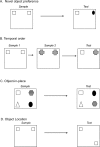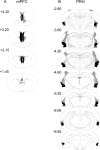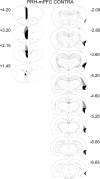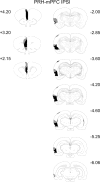Recognition memory for objects, place, and temporal order: a disconnection analysis of the role of the medial prefrontal cortex and perirhinal cortex
- PMID: 17360918
- PMCID: PMC6672574
- DOI: 10.1523/JNEUROSCI.5289-06.2007
Recognition memory for objects, place, and temporal order: a disconnection analysis of the role of the medial prefrontal cortex and perirhinal cortex
Abstract
Recognition memory requires judgments of the previous occurrence of stimuli made on the basis of the relative familiarity of individual objects, or by integrating information concerning objects and location, or by using recency information. The present study examined the role of the medial prefrontal cortex (mPFC) and perirhinal cortex (PRH) in these distinct recognition memory processes using a series of behavioral tests: a novel object preference task, an object-in-place task, and a temporal order memory task. Also, a disconnection procedure was used to test whether these regions form components of an integrated system for recognition memory. Male DA rats received bilateral lesions in the PRH or mPFC or unilateral lesions placed in both cortices in either the same (PRH-mPFC IPSI) or contralateral (PRH-mPFC CONTRA) hemispheres. A fifth group underwent sham surgery (SHAM). In the object-in-place and temporal order memory tasks, the PRH, mPFC, and PRH-mPFC CONTRA groups were significantly impaired. However, performance in the novel object preference task was only impaired in the PRH group. No group was impaired in the object location task. These results demonstrate that the mPFC and PRH are crucial for object-in-place associational and recency discriminations, whereas the PRH but not the mPFC is important for the discrimination of novel and familiar individual objects. Importantly, these results provide direct support for the hypothesis that to make discriminations based on associational or recency information, both cortical regions operate within an integrated neural network for recognition memory.
Figures









References
-
- Bachevalier J, Mishkin M. Visual recognition impairment follows ventromedial but not dorsolateral prefrontal lesions in monkeys. Behav Brain Res. 1986;20:249–261. - PubMed
-
- Beckstead R. An autoradiographic examination of corticocortical and subcortical projections of the mediodorsal-projection (prefrontal) cortex in the rat. J Comp Neurol. 1979;184:43–62. - PubMed
-
- Brown M, Aggleton J. Recognition memory: what are the roles of the perirhinal cortex and hippocampus? Nat Rev Neurosci. 2001;2:51–61. - PubMed
-
- Brown M, Xiang J. Recognition memory: neuronal substrates of the judgement of prior occurrence. Prog Neurobiol. 1998;55:149–189. - PubMed
-
- Brown M, Wilson F, Riches I. Neuronal evidence that inferomedial temporal cortex is more important than hippocampus in certain processes underlying recognition memory. Brain Res. 1987;409:158–162. - PubMed
Publication types
MeSH terms
Grants and funding
LinkOut - more resources
Full Text Sources
